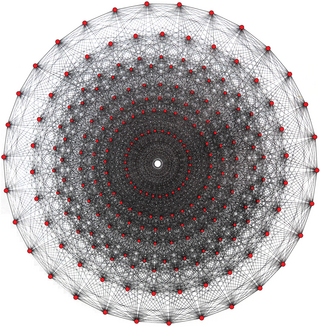Witting polytope
| Witting polytope | |
|---|---|

| |
| Schläfli symbol | 3{3}3{3}3{3}3 |
| Coxeter diagram | |
| Cells | 2403{3}3{3}3
|
| Faces | 21603{3}3 |
| Edges | 21603{} |
| Vertices | 240 |
| Petrie polygon | 30-gon |
| van Oss polygon | 903{4}3
|
| Shephard group | L4=3[3]3[3]3[3]3,order 155,520 |
| Dual polyhedron | Self-dual |
| Properties | Regular |
In 4-dimensional complexgeometry,theWitting polytopeis aregular complex polytope,named as:3{3}3{3}3{3}3,andCoxeter diagram![]()
![]()
![]()
![]()
![]()
![]()
![]() .It has 240 vertices, 21603{} edges, 21603{3}3faces, and 2403{3}3{3}3cells. It is self-dual. Each vertex belongs to 27 edges, 72 faces, and 27 cells, corresponding to theHessian polyhedronvertex figure.
.It has 240 vertices, 21603{} edges, 21603{3}3faces, and 2403{3}3{3}3cells. It is self-dual. Each vertex belongs to 27 edges, 72 faces, and 27 cells, corresponding to theHessian polyhedronvertex figure.
Symmetry
[edit]Its symmetry by3[3]3[3]3[3]3or![]()
![]()
![]()
![]()
![]()
![]()
![]() ,order 155,520.[1]It has 240 copies of
,order 155,520.[1]It has 240 copies of![]()
![]()
![]()
![]()
![]() ,order 648 at each cell.[2]
,order 648 at each cell.[2]
Structure
[edit]Theconfiguration matrixis:[3]
The number of vertices, edges, faces, and cells are seen in the diagonal of the matrix. These are computed by the order of the group divided by the order of the subgroup, by removing certain complex reflections, shown with X below. The number of elements of the k-faces are seen in rows below the diagonal. The number of elements in the vertex figure, etc., are given in rows above the digonal.
| L4 | k-face | fk | f0 | f1 | f2 | f3 | k-figure | Notes | |
|---|---|---|---|---|---|---|---|---|---|
| L3 | ( ) | f0 | 240 | 27 | 72 | 27 | 3{3}3{3}3 | L4/L3= 216*6!/27/4! = 240 | |
| L2L1 | 3{ } | f1 | 3 | 2160 | 8 | 8 | 3{3}3 | L4/L2L1= 216*6!/4!/3 = 2160 | |
| 3{3}3 | f2 | 8 | 8 | 2160 | 3 | 3{ } | |||
| L3 | 3{3}3{3}3 | f3 | 27 | 72 | 27 | 240 | ( ) | L4/L3= 216*6!/27/4! = 240 |
Coordinates
[edit]Its 240 vertices are given coordinates in:
|
|
where.
The last 6 points form hexagonalholeson one of its 40 diameters. There are 40hyperplanescontain central3{3}3{4}2,![]()
![]()
![]()
![]()
![]() figures, with 72 vertices.
figures, with 72 vertices.
Witting configuration
[edit]Coxeter named it afterAlexander Wittingfor being aWittingconfigurationin complex projective 3-space:[4]
- or
The Witting configuration is related to the finite space PG(3,22), consisting of 85 points, 357 lines, and 85 planes.[5]
Related real polytope
[edit]Its 240 vertices are shared with the real 8-dimensional polytope421,![]()
![]()
![]()
![]()
![]()
![]()
![]()
![]()
![]()
![]()
![]()
![]()
![]() .Its 2160 3-edges are sometimes drawn as 6480 simple edges, slightly less than the 6720 edges of 421.The 240 difference is accounted by 40 central hexagons in 421whose edges are not included in3{3}3{3}3{3}3.[6]
.Its 2160 3-edges are sometimes drawn as 6480 simple edges, slightly less than the 6720 edges of 421.The 240 difference is accounted by 40 central hexagons in 421whose edges are not included in3{3}3{3}3{3}3.[6]
The honeycomb of Witting polytopes
[edit]The regular Witting polytope has one further stage as a4-dimensional honeycomb,![]()
![]()
![]()
![]()
![]()
![]()
![]()
![]()
![]() .It has the Witting polytope as both its facets, and vertex figure. It is self-dual, and its dual coincides with itself.[7]
.It has the Witting polytope as both its facets, and vertex figure. It is self-dual, and its dual coincides with itself.[7]
Hyperplane sections of this honeycomb include 3-dimensional honeycombs![]()
![]()
![]()
![]()
![]()
![]()
![]() .
.
The honeycomb of Witting polytopes has a real representation as the 8-dimensional polytope521,![]()
![]()
![]()
![]()
![]()
![]()
![]()
![]()
![]()
![]()
![]()
![]()
![]()
![]()
![]() .
.
Itsf-vectorelement counts are in proportion: 1, 80, 270, 80, 1.[8]Theconfiguration matrixfor the honeycomb is:
| L5 | k-face | fk | f0 | f1 | f2 | f3 | f4 | k-figure | Notes | |
|---|---|---|---|---|---|---|---|---|---|---|
| L4 | ( ) | f0 | N | 240 | 2160 | 2160 | 240 | 3{3}3{3}3{3}3 | L5/L4=N | |
| L3L1 | 3{ } | f1 | 3 | 80N | 27 | 72 | 27 | 3{3}3{3}3 | L5/L3L1= 80N | |
| L2L2 | 3{3}3 | f2 | 8 | 8 | 270N | 8 | 8 | 3{3}3 | L5/L2L2= 270N | |
| L3L1 | 3{3}3{3}3 | f3 | 27 | 72 | 27 | 80N | 3 | 3{} | L5/L3L1= 80N | |
| L4 | 3{3}3{3}3{3}3 | f4 | 240 | 2160 | 2160 | 240 | N | ( ) | L5/L4=N |
Notes
[edit]- ^Coxeter Regular Convex Polytopes, 12.5 The Witting polytope
- ^Coxeter, Complex Regular Polytopes, p.134
- ^Coxeter, Complex Regular polytopes, p.132
- ^Alexander Witting, Ueber Jacobi'sche Functionen kterOrdnung Zweier Variabler, Mathemematische Annalen 29 (1887), 157-70, see especially p.169
- ^Coxeter, Complex regular polytopes, p.133
- ^Coxeter, Complex Regular Polytopes, p.134
- ^Coxeter, Complex Regular Polytopes, p.135
- ^Coxeter Regular Convex Polytopes, 12.5 The Witting polytope
References
[edit]- Coxeter, H. S. M.and Moser, W. O. J.;Generators and Relations for Discrete Groups(1965), esp pp 67–80.
- Coxeter, H. S. M.;Regular Complex Polytopes,Cambridge University Press, second edition (1991). pp. 132–5, 143, 146, 152.
- Coxeter, H. S. M.and Shephard, G.C.; Portraits of a family of complex polytopes,LeonardoVol 25, No 3/4, (1992), pp 239–244[1]

![{\displaystyle \left[{\begin{smallmatrix}240&27&72&27\\3&2160&8&8\\8&8&2160&3\\27&72&27&240\end{smallmatrix}}\right]}](https://wikimedia.org/api/rest_v1/media/math/render/svg/8c7dcd1aaf99fa519c4740d6d553ab0f4445980b)


![{\displaystyle \left[{\begin{smallmatrix}40&12&12\\2&240&2\\12&12&40\end{smallmatrix}}\right]}](https://wikimedia.org/api/rest_v1/media/math/render/svg/4595e36b413dfbbc2e0c6a9a1047030a40375f04)
![{\displaystyle \left[{\begin{smallmatrix}40&9&12\\4&90&4\\12&9&40\end{smallmatrix}}\right]}](https://wikimedia.org/api/rest_v1/media/math/render/svg/fc42b73d1cf1ba3aa154d93c64392f36bb489074)